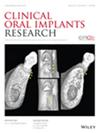The Use of the Facial Sinus Wall as Bone Shell Onlay Graft for Maxillary Posterior Ridge Reconstruction: A Retrospective Case Series
Abstract
Purpose
To evaluate the performance and clinical outcome of vertical and horizontal bone augmentation (VHBA) in posterior maxillary regions combining lateral window sinus floor elevation (LWSFE) with a horizontal bone shell technique applying the maxillary facial sinus wall as a bone plate.
Materials and Methods
In 18 patients, LWSFE was combined with a horizontal bone shield augmentation procedure utilizing the maxillary facial sinus bone wall as a lateral bone plate. Both the sinus cavity and the lateral bone box created were grafted with a mixture of autogenous bone/venous blood and bovine bone mineral. The primary aim was to assess the performance of combined techniques enabling subsequent implant placement. Using radiographic measurements (preoperative, after VHBA, at implant placement, and at follow-up), bone gain/reduction of augmented horizontal ridge width (HRW) and vertical bone height (VBH) were evaluated. Additionally, clinical outcome assessing implant survival/success rate, marginal bone loss (MBL), and implant health (mucositis/peri-implantitis) was evaluated.
Results
For the combined VHBA techniques, HRW and VBH increased significantly (p < 0.001) from preoperative 3.5 ± 1.4 mm/3.6 ± 2.1 mm to 9.7 ± 1.9 mm/18.0 ± 1.6 mm post-augmentation. However, HRW and VBH dimensions decreased up to 8.9 ± 1.8 mm/17.1 ± 1.4 mm at implant placement and 8.6 ± 1.7 mm/16.7 ± 1.3 mm at follow-up evaluation (3.8 ± 1.8 years; p < 0.001, respectively). Augmented bone reduction was significantly higher (−7.7%) between the augmentation procedure and implant placement than in the post-implant-placement period (−2.5%). All implants survived (100%) representing peri-implant MBL of −0.9 ± 0.7 mm, pocket depth of 3.4 + 1.8 mm, and prevalences of 5%/0% for peri-implant mucositis/peri-implantitis.
Conclusion
The combination of horizontal bone augmentation using local bone shield transfer from the maxillary facial sinus wall with LWSFE enables sufficient reconstruction of maxillary posterior ridge.

 求助内容:
求助内容: 应助结果提醒方式:
应助结果提醒方式:


